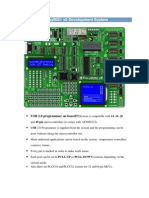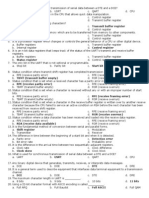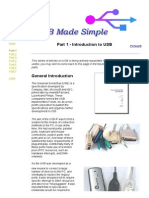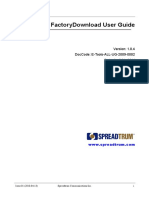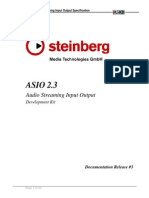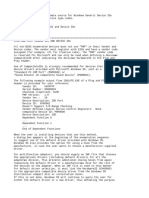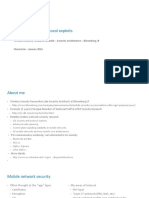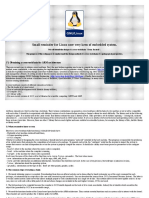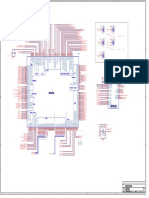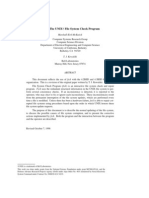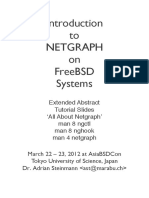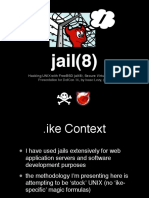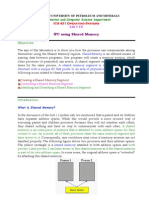Open Source GSM Stack in Linux
Uploaded by
wanna_acOpen Source GSM Stack in Linux
Uploaded by
wanna_acIntroduction Porting Linux to new platform Running GSM RF parts Summary
Getting the rst Open Source GSM stack in Linux
Marcin Mielczarczyk <marcin.mielczarczyk@tieto.com> Krzysztof Antonowicz <krzysztof.antonowicz@tieto.com>
Tieto
Embedded Linux Conference 2012, Redwood Shores, CA
Marcin Mielczarczyk, Krzysztof Antonowicz
Getting the rst Open Source GSM stack in Linux
Tieto
Introduction Porting Linux to new platform Running GSM RF parts Summary
Outline
Introduction Open Source GSM stack Mediatek platform Sciphone Dream G2 2 Porting Linux to new platform HW reverse engineering Executing own code Porting U-Boot Porting Linux 3 Running GSM RF parts GSM RF schematics Description of GSM RF parts DSP reverse engineering Yet to do 4 Summary Marcin Mielczarczyk, Krzysztof Antonowicz Mediateks platform futureGetting the rst Open Source GSM stack in Linux
1
Tieto
Introduction Porting Linux to new platform Running GSM RF parts Summary
Open Source GSM stack Mediatek platform Sciphone Dream G2
Introduction
Dont we already have open source mobile phones?
Marcin Mielczarczyk, Krzysztof Antonowicz
Getting the rst Open Source GSM stack in Linux
Tieto
Introduction Porting Linux to new platform Running GSM RF parts Summary
Open Source GSM stack Mediatek platform Sciphone Dream G2
Open Source GSM stack
Are there any open source GSM stacks?
Marcin Mielczarczyk, Krzysztof Antonowicz
Getting the rst Open Source GSM stack in Linux
Tieto
Introduction Porting Linux to new platform Running GSM RF parts Summary
Open Source GSM stack Mediatek platform Sciphone Dream G2
OsmocomBB
OsmocomBB (Open Source MObile COMmunication Base Band) Supported phones: Compal/Motorola C11x, C12x, C13x, C14x and C15x Calypso DBB based on ARM7TDMI GSM L1 runs on a mobile phone GSM L2/L3 runs on a PC Its possible to make GSM Voice calls No new phones with Calypso since about 2008
Marcin Mielczarczyk, Krzysztof Antonowicz
Getting the rst Open Source GSM stack in Linux
Tieto
Introduction Porting Linux to new platform Running GSM RF parts Summary
Open Source GSM stack Mediatek platform Sciphone Dream G2
OsmocomBB
Marcin Mielczarczyk, Krzysztof Antonowicz
Getting the rst Open Source GSM stack in Linux
Tieto
Introduction Porting Linux to new platform Running GSM RF parts Summary
Open Source GSM stack Mediatek platform Sciphone Dream G2
Mediatek platform
Low cost phones based on Mediatek platform Feature phones which are mainly fakes of known brands (Nokla, Sany-Ericssan, sciPHONE) Most popular SoC is MT622x (based on ARM7TDMI) A lot of peripherals included (camera, analog TV, FM transmitter) Available and cheap ($30 - $100) Platform acquired from Analog Devices
Marcin Mielczarczyk, Krzysztof Antonowicz Getting the rst Open Source GSM stack in Linux Tieto
Introduction Porting Linux to new platform Running GSM RF parts Summary
Open Source GSM stack Mediatek platform Sciphone Dream G2
Mediatek platform
ARM7TDMI is not our target, we want to run Linux to have more possibilities. Does Mediatek have something better?
Marcin Mielczarczyk, Krzysztof Antonowicz
Getting the rst Open Source GSM stack in Linux
Tieto
Introduction Porting Linux to new platform Running GSM RF parts Summary
Open Source GSM stack Mediatek platform Sciphone Dream G2
Sciphone Dream G2
Sciphone Dream G2 running fake Android Fake of HTC Dream G2 (released before HTC) Running Nucleus RTOS with UI like Android Based on MT6235 SoC (ARM926EJS) Resistive touch screen, WiFi, BT, FM radio, USB, SD/MMC Low cost, starting from $50 Other devices available with MT6235 SoC
Marcin Mielczarczyk, Krzysztof Antonowicz Getting the rst Open Source GSM stack in Linux Tieto
Introduction Porting Linux to new platform Running GSM RF parts Summary
Open Source GSM stack Mediatek platform Sciphone Dream G2
MT6235
MT6235 characteristics: Single core ARM926EJ-S 208MHz Advanced DSP functionality PMU / Touch panel driver intergated SD/MMC and SDIO support Built in USB2.0 USIM support EDGE class 12, GPRS class 12 Highly integrated (DBB and ABB in one chip) Datasheet easily available on the Internet
Marcin Mielczarczyk, Krzysztof Antonowicz Getting the rst Open Source GSM stack in Linux Tieto
Introduction Porting Linux to new platform Running GSM RF parts Summary
HW reverse engineering Executing own code Porting U-Boot Porting Linux
How to begin
What do we need, to run Linux on new platform? Datasheet for the SoC Know how to run custom code Debug interface (JTAG, UART) Is cpu architecture already supported by Linux kernel?
Marcin Mielczarczyk, Krzysztof Antonowicz
Getting the rst Open Source GSM stack in Linux
Tieto
Introduction Porting Linux to new platform Running GSM RF parts Summary
HW reverse engineering Executing own code Porting U-Boot Porting Linux
Finding HW pins
We need to have interface to load binary code to mobile phone Finding JTAG will speed up development a lot, so its worth to spend time on it
Very often not populated on PCB At least 4 pins to nd (TCK, TDO, TDI, TMS)
UART is easier to nd (just 2 pins) and very often available on external connector Use software for that, i.e. JTAG nder:
Built on ATMega32 (3.3V - 5V, 32 GPIOs) Easy to build, even on solderless breadboard Scanning of pins takes couple of seconds
Marcin Mielczarczyk, Krzysztof Antonowicz
Getting the rst Open Source GSM stack in Linux
Tieto
Introduction Porting Linux to new platform Running GSM RF parts Summary
HW reverse engineering Executing own code Porting U-Boot Porting Linux
JTAG nder hardware
Marcin Mielczarczyk, Krzysztof Antonowicz
Getting the rst Open Source GSM stack in Linux
Tieto
Introduction Porting Linux to new platform Running GSM RF parts Summary
HW reverse engineering Executing own code Porting U-Boot Porting Linux
JTAG and UART pins
Marcin Mielczarczyk, Krzysztof Antonowicz
Getting the rst Open Source GSM stack in Linux
Tieto
Introduction Porting Linux to new platform Running GSM RF parts Summary
HW reverse engineering Executing own code Porting U-Boot Porting Linux
Executing own code
Try to nd ashing tool for given SoC
Usually such tools upload loaders which are executed on target Such loaders have code for specic peripherals (i.e. ash/RAM memory) Loader can be signed Sometimes youre able to load your own code using this tool Start from snifng communication between PC and target
If JTAG has been found, much easier to analyze code
Direct access to registers, memory, peripherals Easy to load code Realtime debugging (current status of HW state)
Marcin Mielczarczyk, Krzysztof Antonowicz
Getting the rst Open Source GSM stack in Linux
Tieto
Introduction Porting Linux to new platform Running GSM RF parts Summary
HW reverse engineering Executing own code Porting U-Boot Porting Linux
SDRAM initialization
First problem: How to init SDRAM memory?
Find out memory chip model and get datasheet Disassemble loader uploaded by asher (if loader contains SDRAM initialization) Disassemble bootloader code
MT6235 has 64kB static RAM, where SBL is loaded Even on the same model of phone, peripherals can differ (NAND, SDRAM, keypad, LCD)
Marcin Mielczarczyk, Krzysztof Antonowicz
Getting the rst Open Source GSM stack in Linux
Tieto
Introduction Porting Linux to new platform Running GSM RF parts Summary
HW reverse engineering Executing own code Porting U-Boot Porting Linux
Porting U-Boot
Getting U-Boot running on new platform is extremely easy (if SoC is based on ARM) Just two drivers are needed to get U-Boot prompt:
UART Timer
Even if you see U-Boot source code for the rst time it shouldnt take more than one day to get it running on new platform Bootloader is a good place to understand how peripherals work (testing basic drivers)
Marcin Mielczarczyk, Krzysztof Antonowicz
Getting the rst Open Source GSM stack in Linux
Tieto
Introduction Porting Linux to new platform Running GSM RF parts Summary
HW reverse engineering Executing own code Porting U-Boot Porting Linux
U-Boot UART driver
static void mt62xx_putc(int portnum, char c) { /* Wait until there is space in the FIFO */ while(!(readw(port[portnum] + MTK_UART_LSR) & UART_L WATCHDOG_RESET(); /* Send the character */ writew(c, port[portnum] + MTK_UART_DR); }
Marcin Mielczarczyk, Krzysztof Antonowicz
Getting the rst Open Source GSM stack in Linux
Tieto
Introduction Porting Linux to new platform Running GSM RF parts Summary
HW reverse engineering Executing own code Porting U-Boot Porting Linux
U-Boot UART driver
static int mt62xx_getc(int portnum) { /* Wait until there is data in the FIFO */ while (!(readl(port[portnum] + MTK_UART_LSR) & UART_ WATCHDOG_RESET(); return readl(port[portnum] + MTK_UART_DR); }
Marcin Mielczarczyk, Krzysztof Antonowicz
Getting the rst Open Source GSM stack in Linux
Tieto
Introduction Porting Linux to new platform Running GSM RF parts Summary
HW reverse engineering Executing own code Porting U-Boot Porting Linux
Porting Linux
Assumption: Architecture is already supported (i.e. ARM) Linux porting of course takes longer than U-Boot porting To get Linux prompt following drivers are needed:
UART Timer Interrupt controller
Add some constant denitions, generic functions and default conguration Usually it takes one week to get prompt in Linux
Marcin Mielczarczyk, Krzysztof Antonowicz
Getting the rst Open Source GSM stack in Linux
Tieto
Introduction Porting Linux to new platform Running GSM RF parts Summary
HW reverse engineering Executing own code Porting U-Boot Porting Linux
Timeline
Marcin Mielczarczyk, Krzysztof Antonowicz
Getting the rst Open Source GSM stack in Linux
Tieto
Introduction Porting Linux to new platform Running GSM RF parts Summary
HW reverse engineering Executing own code Porting U-Boot Porting Linux
Additional hardware
Marcin Mielczarczyk, Krzysztof Antonowicz
Getting the rst Open Source GSM stack in Linux
Tieto
Introduction Porting Linux to new platform Running GSM RF parts Summary
HW reverse engineering Executing own code Porting U-Boot Porting Linux
Running Linux distro
OpenEmbedded used to build Linux distribution When drivers are already implemented it works out of the box OPIE (Open Palmtop Integrated Environment)
Graphical user interface for PDAs A lot of applications and games available Minimal requirements:
CPU: 80386, ARM 7 Touch screen 320x240 10MB of ash memory
Its possible to run "real" Android 1.5
Marcin Mielczarczyk, Krzysztof Antonowicz Getting the rst Open Source GSM stack in Linux Tieto
Introduction Porting Linux to new platform Running GSM RF parts Summary
GSM RF schematics Description of GSM RF parts DSP reverse engineering Yet to do
GSM RF simplied schematics
Marcin Mielczarczyk, Krzysztof Antonowicz
Getting the rst Open Source GSM stack in Linux
Tieto
Introduction Porting Linux to new platform Running GSM RF parts Summary
GSM RF schematics Description of GSM RF parts DSP reverse engineering Yet to do
GSM RF chips
Drivers written in U-Boot for following RF HW:
Murata LMSP33CA-465 - antenna switch RF3159 - dual-mode amplier MT6140 - GSM/GPRS/EDGE RF transceiver BSI - Baseband Serial Interface BPI - Baseband Parallel Interface BFE - Baseband Front End TDMA - Time Division Multiple Access APC - Automatic Power Control
U-Boot command:
rf_tx <arfcn>
Marcin Mielczarczyk, Krzysztof Antonowicz Getting the rst Open Source GSM stack in Linux Tieto
Introduction Porting Linux to new platform Running GSM RF parts Summary
GSM RF schematics Description of GSM RF parts DSP reverse engineering Yet to do
Testing drivers for TX path
Marcin Mielczarczyk, Krzysztof Antonowicz
Getting the rst Open Source GSM stack in Linux
Tieto
Introduction Porting Linux to new platform Running GSM RF parts Summary
GSM RF schematics Description of GSM RF parts DSP reverse engineering Yet to do
DSP reverse engineering
DSP in BaseBand ASIC is the biggest secret of manufacturers In MT6235 datasheet there are 20 pages missing (in ARM-DSP interface chapter) Very often this part has no documentation at all
Marcin Mielczarczyk, Krzysztof Antonowicz
Getting the rst Open Source GSM stack in Linux
Tieto
Introduction Porting Linux to new platform Running GSM RF parts Summary
GSM RF schematics Description of GSM RF parts DSP reverse engineering Yet to do
DSP reverse engineering
Facts about DSP in MT6235: Most probably Analog Devices ADSP-2181 Code for DSP is located in ROM (not downloaded over IDMA) DSP patch unit exists (possibility of potential hack) So far we didnt manage to execute own code on DSP So far we didnt manage to dump existing code on DSP Best approach would be to use DSP as black box
Marcin Mielczarczyk, Krzysztof Antonowicz
Getting the rst Open Source GSM stack in Linux
Tieto
Introduction Porting Linux to new platform Running GSM RF parts Summary
GSM RF schematics Description of GSM RF parts DSP reverse engineering Yet to do
Yet to do: Investigate more on DSP (blocking point at the moment) Port OsmocomBB to MTK HW Adopt OsmocomBB to Linux Final result: We can get rst fully open source mobile phone Lots of possibilities (acquiring logs, snifng, etc.)
Marcin Mielczarczyk, Krzysztof Antonowicz
Getting the rst Open Source GSM stack in Linux
Tieto
Introduction Porting Linux to new platform Running GSM RF parts Summary
Mediateks platform future Copycat phones Questions
Summary
Fake mobile phones market is really interesting Porting Linux to new platform based on ARM is easy HW/SW reverse engineering takes long time Running own code is most important step Baseband chips are well protected by manufacturers Were on good track to get rst fully open source mobile phone
Marcin Mielczarczyk, Krzysztof Antonowicz
Getting the rst Open Source GSM stack in Linux
Tieto
Introduction Porting Linux to new platform Running GSM RF parts Summary
Mediateks platform future Copycat phones Questions
Does Mediatek platform have any future?
MT6516
ARM926EJ-S @ 416MHz (application) ARM7 @ 104MHz (baseband) Quad-Band GSM/GPRS/EDGE
MT6573 (1GHz = 650MHz + 400MHz)
ARM11 @ 650MHz (application) ARM9 @ 400MHz (baseband) WCDMA + GSM (MT6162)
A lot of peripherals from new SoCs are very similar to MT6235 Tons of MTK based phones are cheap and available on the market MTK hardware is very stable!
Marcin Mielczarczyk, Krzysztof Antonowicz Getting the rst Open Source GSM stack in Linux Tieto
Introduction Porting Linux to new platform Running GSM RF parts Summary
Mediateks platform future Copycat phones Questions
Touch Galaxy S2 HDC A9100/i9100 1GHz Android
Marcin Mielczarczyk, Krzysztof Antonowicz
Getting the rst Open Source GSM stack in Linux
Tieto
Introduction Porting Linux to new platform Running GSM RF parts Summary
Mediateks platform future Copycat phones Questions
Questions?
Marcin Mielczarczyk, Krzysztof Antonowicz
Getting the rst Open Source GSM stack in Linux
Tieto
You might also like
- Insecure Boot: Andrea Barisani - Head of Hardware SecurityNo ratings yetInsecure Boot: Andrea Barisani - Head of Hardware Security42 pages
- How To Use SP Flash Tool To Backup Mediatek FirmwareNo ratings yetHow To Use SP Flash Tool To Backup Mediatek Firmware16 pages
- Linux Kernel Programming: A comprehensive and practical guide to kernel internals, writing modules, and kernel synchronizationFrom EverandLinux Kernel Programming: A comprehensive and practical guide to kernel internals, writing modules, and kernel synchronizationNo ratings yet
- The DB9-USB Family of UART Converter Modules: DatasheetNo ratings yetThe DB9-USB Family of UART Converter Modules: Datasheet26 pages
- eMMC Device Register Linux Kernel InternalsNo ratings yeteMMC Device Register Linux Kernel Internals5 pages
- USB Type-C Specification Release 1.3 PDFNo ratings yetUSB Type-C Specification Release 1.3 PDF241 pages
- Unbrick Your Completely Dead Mi3 With No FastbootNo ratings yetUnbrick Your Completely Dead Mi3 With No Fastboot6 pages
- MediaTek LinkIt Smart 7688 Duo Pin Out v1 3No ratings yetMediaTek LinkIt Smart 7688 Duo Pin Out v1 31 page
- Applea10seriesapplicationprocessor 170822124054No ratings yetApplea10seriesapplicationprocessor 17082212405430 pages
- Flashing Firmware Image Files Using The Rockchip ToolNo ratings yetFlashing Firmware Image Files Using The Rockchip Tool10 pages
- © SANS Institute 2002, Author Retains Full Rights.: Macintosh Forensic Analysis Using Os XNo ratings yet© SANS Institute 2002, Author Retains Full Rights.: Macintosh Forensic Analysis Using Os X13 pages
- How To Download and Install MediaTek USB VCOM Drivers - DroidWinNo ratings yetHow To Download and Install MediaTek USB VCOM Drivers - DroidWin18 pages
- Setup L2TP - IPsec VPN Server On SoftEther VPN Server - SoftEther VPN ProjectNo ratings yetSetup L2TP - IPsec VPN Server On SoftEther VPN Server - SoftEther VPN Project4 pages
- Embedded Linux System Development Training Lab BookNo ratings yetEmbedded Linux System Development Training Lab Book4 pages
- 80096503-001-E ID TECH SecureMag OPOS User's ManualNo ratings yet80096503-001-E ID TECH SecureMag OPOS User's Manual34 pages
- 3.2 Rtlinux Inter-Process Communication (Ipc)No ratings yet3.2 Rtlinux Inter-Process Communication (Ipc)8 pages
- BB5 Easy Service Tool User Manual en Rev2No ratings yetBB5 Easy Service Tool User Manual en Rev224 pages
- Top Artists DNA Graphic From Spotify Data N-Gen ArtNo ratings yetTop Artists DNA Graphic From Spotify Data N-Gen Art1 page
- D-Bus and Polkit, No More Mysticism and ConfusionNo ratings yetD-Bus and Polkit, No More Mysticism and Confusion33 pages
- Government Polytechnic Porbandar: Laboratory ManualNo ratings yetGovernment Polytechnic Porbandar: Laboratory Manual51 pages
- User Manual - H.264 DVR - 20100301 - (5479KB)No ratings yetUser Manual - H.264 DVR - 20100301 - (5479KB)65 pages
- Full Stack Developer Course With Placement SupportNo ratings yetFull Stack Developer Course With Placement Support3 pages
- SGGS Institute of Engg & Technology,: Vishnupuri, NandedNo ratings yetSGGS Institute of Engg & Technology,: Vishnupuri, Nanded9 pages
- Insecure Boot: Andrea Barisani - Head of Hardware SecurityInsecure Boot: Andrea Barisani - Head of Hardware Security
- How To Use SP Flash Tool To Backup Mediatek FirmwareHow To Use SP Flash Tool To Backup Mediatek Firmware
- Linux Kernel Programming: A comprehensive and practical guide to kernel internals, writing modules, and kernel synchronizationFrom EverandLinux Kernel Programming: A comprehensive and practical guide to kernel internals, writing modules, and kernel synchronization
- The DB9-USB Family of UART Converter Modules: DatasheetThe DB9-USB Family of UART Converter Modules: Datasheet
- Flashing Firmware Image Files Using The Rockchip ToolFlashing Firmware Image Files Using The Rockchip Tool
- © SANS Institute 2002, Author Retains Full Rights.: Macintosh Forensic Analysis Using Os X© SANS Institute 2002, Author Retains Full Rights.: Macintosh Forensic Analysis Using Os X
- How To Download and Install MediaTek USB VCOM Drivers - DroidWinHow To Download and Install MediaTek USB VCOM Drivers - DroidWin
- Setup L2TP - IPsec VPN Server On SoftEther VPN Server - SoftEther VPN ProjectSetup L2TP - IPsec VPN Server On SoftEther VPN Server - SoftEther VPN Project
- Embedded Linux System Development Training Lab BookEmbedded Linux System Development Training Lab Book
- 80096503-001-E ID TECH SecureMag OPOS User's Manual80096503-001-E ID TECH SecureMag OPOS User's Manual
- Apple For Business: A Guide to Mac, iPad, and iPhoneFrom EverandApple For Business: A Guide to Mac, iPad, and iPhone
- Top Artists DNA Graphic From Spotify Data N-Gen ArtTop Artists DNA Graphic From Spotify Data N-Gen Art
- Government Polytechnic Porbandar: Laboratory ManualGovernment Polytechnic Porbandar: Laboratory Manual
- Full Stack Developer Course With Placement SupportFull Stack Developer Course With Placement Support
- SGGS Institute of Engg & Technology,: Vishnupuri, NandedSGGS Institute of Engg & Technology,: Vishnupuri, Nanded



